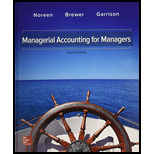
1.
Introduction:
Break-even point:
Break-even point is defined as the volume of production where the total cost is equal to the total sales revenue generated thereby resulting in a no-
To calculate the present yearly net operating income or loss.
2.
Introduction:
Break-even point:
Break-even point is defined as the volume of production where the total cost is equal to the total sales revenue generated thereby resulting in a no-profit and no loss situation. At the break-even point, the contribution earned is sufficient to cover the costs, whereas if the contribution is less than the break-even point then it is a loss and if it is more, then it is a profit.
To calculate: the present break-even point in unit sales and dollar sales.
3.
Introduction:
Break-even point:
Break-even point is defined as the volume of production where the total cost is equal to the total sales revenue generated thereby resulting in a no-profit and no loss situation. At the break-even point, the contribution earned is sufficient to cover the costs, whereas if the contribution is less than the break-even point then it is a loss and if it is more, then it is a profit.
The maximum annual profit that the company can earn if the marketing studies assumption is correct and at how many units and at what selling price per unit would the company generate this profit.
4
Introduction:
Break-even point:
Break-even point is defined as the volume of production where the total cost is equal to the total sales revenue generated thereby resulting in a no-profit and no loss situation. At the break-even point, the contribution earned is sufficient to cover the costs, whereas if the contribution is less than the break-even point then it is a loss and if it is more, then it is a profit.
To calculate: the break-even point in unit sales and dollar sales using the selling price determined in requirement 3 and to explain why is this break-even point different from the break-even point computed in requirement 2
Want to see the full answer?
Check out a sample textbook solution
Chapter 3 Solutions
GEN COMBO MANAGERIAL ACCOUNTING FOR MANAGERS; CONNECT 1S ACCESS CARD
- Bruno Manufacturing uses direct labor-hours in its predetermined overhead rate. At the beginning of the year, the total estimated manufacturing overhead was $680,000. At the end of the year, actual direct labor-hours for the year were 42,500 hours, manufacturing overhead for the year was underapplied by $25,500, and the actual manufacturing overhead was $695,000. The predetermined overhead rate for the year must have been closest to: A) $16.00 B) $15.75 C) $16.35 D) $16.94arrow_forwardWhat was manufactured overhead?arrow_forwardWhich of the following choices is the correct status of manufacturing overhead at year-end?arrow_forward

 AccountingAccountingISBN:9781337272094Author:WARREN, Carl S., Reeve, James M., Duchac, Jonathan E.Publisher:Cengage Learning,
AccountingAccountingISBN:9781337272094Author:WARREN, Carl S., Reeve, James M., Duchac, Jonathan E.Publisher:Cengage Learning, Accounting Information SystemsAccountingISBN:9781337619202Author:Hall, James A.Publisher:Cengage Learning,
Accounting Information SystemsAccountingISBN:9781337619202Author:Hall, James A.Publisher:Cengage Learning, Horngren's Cost Accounting: A Managerial Emphasis...AccountingISBN:9780134475585Author:Srikant M. Datar, Madhav V. RajanPublisher:PEARSON
Horngren's Cost Accounting: A Managerial Emphasis...AccountingISBN:9780134475585Author:Srikant M. Datar, Madhav V. RajanPublisher:PEARSON Intermediate AccountingAccountingISBN:9781259722660Author:J. David Spiceland, Mark W. Nelson, Wayne M ThomasPublisher:McGraw-Hill Education
Intermediate AccountingAccountingISBN:9781259722660Author:J. David Spiceland, Mark W. Nelson, Wayne M ThomasPublisher:McGraw-Hill Education Financial and Managerial AccountingAccountingISBN:9781259726705Author:John J Wild, Ken W. Shaw, Barbara Chiappetta Fundamental Accounting PrinciplesPublisher:McGraw-Hill Education
Financial and Managerial AccountingAccountingISBN:9781259726705Author:John J Wild, Ken W. Shaw, Barbara Chiappetta Fundamental Accounting PrinciplesPublisher:McGraw-Hill Education





